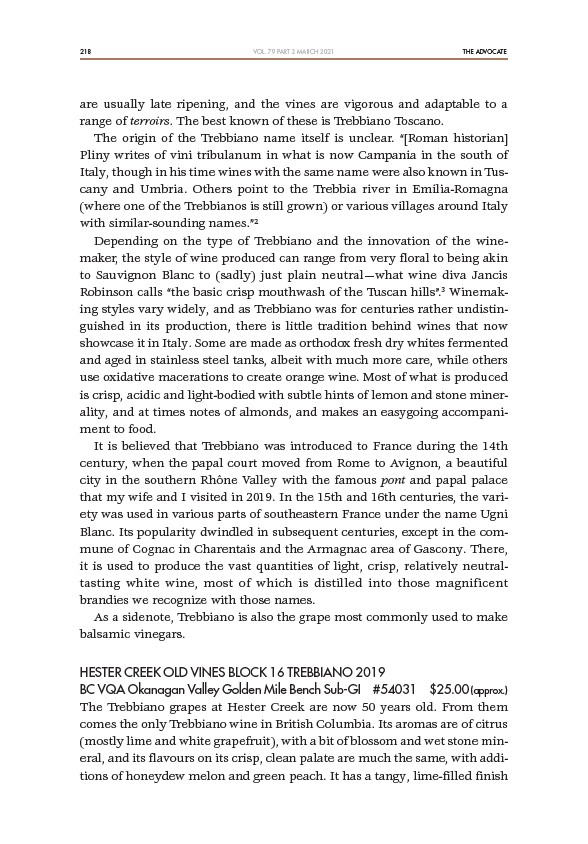
218 THE ADVOCATE
VOL. 79 PART 2 MARCH 2021
are usually late ripening, and the vines are vigorous and adaptable to a
range of terroirs. The best known of these is Trebbiano Toscano.
The origin of the Trebbiano name itself is unclear. “Roman historian
Pliny writes of vini tribulanum in what is now Campania in the south of
Italy, though in his time wines with the same name were also known in Tuscany
and Umbria. Others point to the Trebbia river in Emilia-Romagna
(where one of the Trebbianos is still grown) or various villages around Italy
with similar-sounding names.”2
Depending on the type of Trebbiano and the innovation of the winemaker,
the style of wine produced can range from very floral to being akin
to Sauvignon Blanc to (sadly) just plain neutral—what wine diva Jancis
Robinson calls “the basic crisp mouthwash of the Tuscan hills”.3 Winemaking
styles vary widely, and as Trebbiano was for centuries rather undistinguished
in its production, there is little tradition behind wines that now
showcase it in Italy. Some are made as orthodox fresh dry whites fermented
and aged in stainless steel tanks, albeit with much more care, while others
use oxidative macerations to create orange wine. Most of what is produced
is crisp, acidic and light-bodied with subtle hints of lemon and stone minerality,
and at times notes of almonds, and makes an easygoing accompaniment
to food.
It is believed that Trebbiano was introduced to France during the 14th
century, when the papal court moved from Rome to Avignon, a beautiful
city in the southern Rhône Valley with the famous pont and papal palace
that my wife and I visited in 2019. In the 15th and 16th centuries, the variety
was used in various parts of southeastern France under the name Ugni
Blanc. Its popularity dwindled in subsequent centuries, except in the commune
of Cognac in Charentais and the Armagnac area of Gascony. There,
it is used to produce the vast quantities of light, crisp, relatively neutral-
tasting white wine, most of which is distilled into those magnificent
brandies we recognize with those names.
As a sidenote, Trebbiano is also the grape most commonly used to make
balsamic vinegars.
HESTER CREEK OLD VINES BLOCK 16 TREBBIANO 2019
BC VQA Okanagan Valley Golden Mile Bench Sub-GI #54031 $25.00 (approx.)
The Trebbiano grapes at Hester Creek are now 50 years old. From them
comes the only Trebbiano wine in British Columbia. Its aromas are of citrus
(mostly lime and white grapefruit), with a bit of blossom and wet stone mineral,
and its flavours on its crisp, clean palate are much the same, with additions
of honeydew melon and green peach. It has a tangy, lime-filled finish